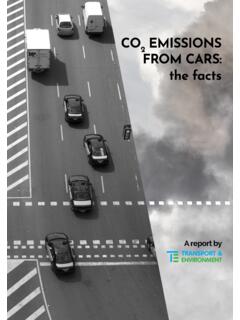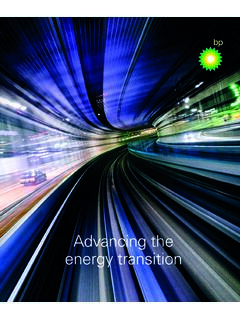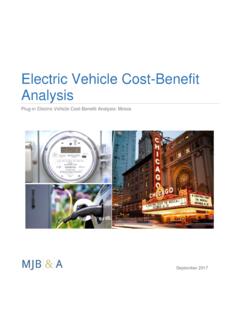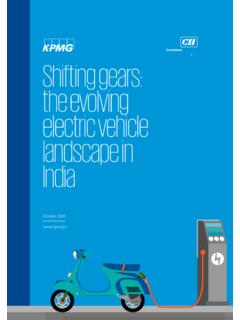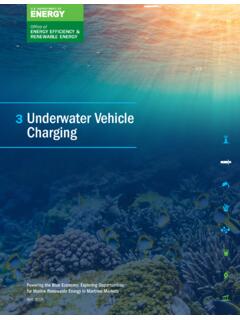Transcription of Indian automotive sector: Creating future-ready organisations
1 Indian automotive sector: Creating future-ready organisations May 2019 2. PwC | Indian automotive sector: Creating future-ready organisations Table of contents automotive industry of the future: The changing paradigm 3 Organisation and workforce of the future in the automotive industry 7 Required skills and capabilities in the automotive sector 12 Bridging the skill and capability gap: Building the right development ecosystem 18 Call to action: The role of business leaders and HR in making organisations future ready 21 Conclusion 24 References 26 1. 2. 3. 4. 5. 6 7 3 PwC | Indian automotive sector: Creating future-ready organisations 1 automotive industry of the future: The changing paradigm 4 PwC | Indian automotive sector: Creating future-ready organisations automotive industry in India The Indian automotive industry is seeing significant transformation with respect to its sustainable growth and profitability.
2 The industry is crucial for the economy as it accounts for of the country s Gross Domestic Product (GDP) and as per automotive Mission Plan (AMP) 2016 26, its contribution is projected to increase to 12%1. India is expected to emerge as the world s third-largest passenger vehicle market by 20212. The fundamentals for growth drivers in the automotive industry remain intact and the sector is likely to see an increased upward trend in demand in the coming years as the economic environment improves and investments increase. The Government s Make in India initiative has played an important role in elevating the country s position and it has improved on nine out of ten parameters for ease of doing business in the last three to four years. Today, India is looked upon as a favourable destination for low-cost manufacturing. The World Economic Forum has ranked it 30th on the Global Manufacturing Index3, which assesses the manufacturing capabilities of countries.
3 The industry attracted Foreign Direct Investment (FDI) worth US$ billion during the period April 2000 to December 2018, according to data released by the Government s Department of Industrial Policy and Promotion (DIPP)1. In this scenario, India s automotive industry (including component manufacturing) is expected to reach US$ billion by 2026. There are a number of key trends that are shaping the industry today, which are expected to have a significant bearing on its ability to realise the objectives of the AMP. In addition to automation of various processes to meet these goals, the sector is also expected to generate additional direct and indirect jobs. Changing paradigm in the industry Currently, India s automotive industry is at an inflexion point and is witnessing five megatrends that are expected to transform the industry in a big way4. Rapidly evolving customer needs, the disruptive impact of technology, the dynamic regulatory environment, changing mobility patterns and global interconnectedness are all impacting the way auto companies are doing business today globally and in India.
4 The industry has never witnessed this magnitude of multi-dimensional change till now. Five megatrends impacting the Indian automotive industry 1 automotive Mission Plan: 2016-26 (A Curtain Raiser) (2015) (last accessed on 20 April 2019) 2 IHS Auto Database, Light vehicle Sales Forecast, (last accessed on 20 April 2019) 3 The Global Competitiveness Report 2018 (last accessed on 20 April 2019) 4 (last accessed on 20 April 2019) 5 PwC | Indian automotive sector: Creating future-ready organisations 1. Rapidly evolving customer expectations: In view of the increasing disparity and gap between middle class population growth versus middle class average income growth5, customers purchase patterns are bifurcating between luxury and economical vehicles. And with disparate and varying spend capacity, high levels of awareness of products, rapidly evolving expectations and the demand for personalised products and services, customers are taking the centre stage in the automotive ecosystem in the country today.
5 In this scenario, development of organisational capabilities that are aligned to business lines and/or segments and are dynamic will help the industry understand changing customer needs and deliver accordingly to meet these needs. 2. Disruptive impact of technology: The car of the future will be electrified, automated, shared, connected and updated yearly to make driving easier, safer, cheaper and more comfortable. In addition, with increasing acceptance of digital solutions, a new wave of emerging technologies are on the cusp of affecting the industry at three levels: a. Vehicles ( electric , driverless and connected; with smart sensors, real time vehicle tracking, geo fencing, driver analysis and remote diagnostics) b. Supply chain and operations (digitised trucking, upcoming logistics hubs, automated warehouses, robotics, augmented reality and IoT) c. Business models (mobility as a service and vehicle sharing) The Indian Government has the ambitious target of ensuring that only electric vehicles are sold in the country within the next few years.
6 The Ministry of Heavy Industries has shortlisted 11 cities in the country for introduction of electric vehicles (EVs) in their public transport systems under the Faster Adoption and Manufacturing of ( hybrid ) and electric vehicles in India (FAME) scheme6. The first phase of the scheme has been extended to March 2019. In February 2019, the Government approved the FAME-II scheme with a fund requirement of INR 10,000 crore (US$ billion) for FY20-22. The number of vehicles supported under the FAME scheme increased to 192,451 in March 2018 from 5,197 units in June 2015. 5 PwC. (2014). Adapt to survive: How better alignment between talent and opportunity can drive economic growth. Retrieved from (last accessed on 20 April 2019) Going forward, with new technologies coming in, organisations technology capital will be the key differentiator. Digital transformation and speed of execution will be the key requirements for the survival of most automotive organisations .
7 3. Dynamic regulatory environment: India, an emerging economy, has been traditionally looked upon as a favourable destination for low-cost manufacturing. However, regulatory pressure and the benefit of industry enablers are expected to have a disruptive effect on the portfolios of vehicles and the automotive supply chain. Major regulatory interventions such as the following are planned: a. Adoption of BSVI norms in Delhi/NCR by 2019 and pan India by 2020 for all new four-wheeler vehicles sold b. Change in tax structure GST and resultant costs c. Government investment on the automotive sector and its plans for infrastructure development (Pradhan Mantri Gram Parivahan Yojana, Bharatmala Pariyojana, etc.) d. Adoption of safety standards in line with international norms e. Formulation of end-of-life or scrappage policies f. Implementation of Corporate Average Fuel Efficiency norms4 under which manufacturers need to improve their fuel efficiency by 10% between 2017 and 2021 and 30% or more by 2022 g.
8 Adoption of EVs and alternative fuels through FAME-2 Stringent vehicle -related standards are leading to a shift in vehicular technology. automotive organisations therefore need to invest in developing various technical skills that are relevant in this era of changing vehicular technologies. 6 Indian Automobile Industry Analysis: A Sectoral Report. Indian Brand Equity Foundation. (2019). (last accessed on 20 April 2019) 6 PwC | Indian automotive sector: Creating future-ready organisations 4. Changing face of mobility infrastructure: Self-driving vehicles, ride-hailing services and other technologies are transforming mobility. The development of alternative modes of mobility ( autonomous vehicles and electric vehicles ) alongside that of smart infrastructure ( smart cities, optimisation of parking space, artificial intelligence (AI)-driven traffic lights and the focus on enablement of EV-charging infrastructure) is projected to transform mobility infrastructure.
9 In this environment, India s efforts to support EVs are likely to focus on two-wheelers, public transport and fleet operations such as taxis and three-wheelers. According to the report by Bloomberg New Energy Finance (BNEF), India will see much progress on electric two-wheelers, rickshaws and electric buses over the next 10 years and by 2040, EVs will constitute 40% of the total passenger vehicle fleet in the country7. However, while transportation infrastructure continues to be augmented, EV-charging infrastructure (with less than 1000 charging stations in India) is yet to take off. In this scenario, the industry is expected to face unique challenges with changing mobility infrastructure, the specifications of fast-charging standards and exploration of enhanced technology options. 5. Globally interconnected industry: Global and local markets offer a sustained growth potential for the Indian automotive industry. An increase of FDI in India and the emergence and adoption of globally emerging megatrends and technologies in the country are expected to result in the country s increased dependence on other countries at every step of the automotive value chain, R&D, purchase of raw material, power electronics, manufacturing support and sales.
10 Therefore, automotive organisations ability to put in place and implement effective global and local strategies to manage risks and build their capability to drive their strategies will be of paramount importance. These megatrends are already affecting the industry, and as we look ahead, we realise that thriving in this changing environment will require automotive organisations (across the value chain) to make several fundamental changes in their way of working in order to drive profitable growth and remain relevant in the market. This will also mean a shift in the way the industry thinks about talent and capability requirements in the future. These changes will also offer an opportunity to automotive industry participants to use digitalisation as an enabler to create a unique competitive advantage across the value chain. The industry will therefore need to gear itself for a cultural shift, structural changes, job disruptions and major skill and capability building to compete with global players, maintain and create a competitive edge, and cater according to global requirements and standards.










